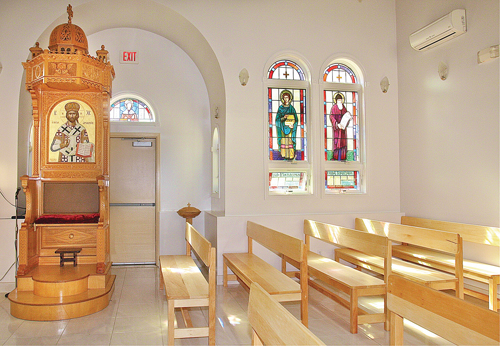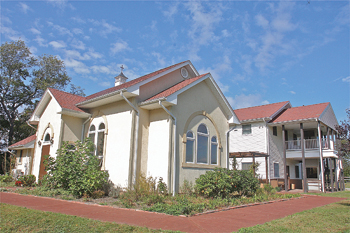
The chapel’s sanctuary has simple pews and porcelain floors.
From the outside, the structure is a conventional representation of a modern place of Christian worship, with pale yellow siding and stained glass windows.
It’s a design choice the chapel’s architect, Yanni Pavlidis of Smithtown, said was deliberately made to fit in with the abbey’s rural suburban backdrop.
“I wanted to do something to fit in with the surrounding area,” Mr. Pavlidis said. An independent architect since 1990, Mr. Pavlidis was born in Constantinople and has designed numerous monasteries. Construction at All Saints began in 2000 and was completed in 2007, he said.
“It could pass for any other house or church,” Mr. Pavlidis said of the chapel, which was built using donated funds. “It is typical Long Island.”

BARBARAELLEN
KOCH PHOTO | The chapel at All Saints Greek Orthodox Monastery in
Calverton. The building faces east, which is traditional in the Greek
Orthodox religion. Next door is the nuns’ residence.
The chapel at All Saints is bursting with colors, like blue and gold. The floor, crafted from smooth white porcelain, lends an elegant touch.
“The Orthodox Church says the outside [of the church] doesn’t matter as long as the inside is inspiring and good,” Mr. Pavlidis said.
One of the chief ways the Greek Orthodox Church seeks to inspire worshipers, Mr. Pavlidis said, is through two-dimensional paintings of Christian saints, and the chapel has several.
“The saint himself [appears to be] looking at you straight-on,” he said of the visual technique used in the paintings. “They are located in critical places. For instance, as you enter, if you look up you will see the Pantokrator, which is the Almighty.”

BARBARAELLEN KOCH PHOTO | The monastery’s founder, Sister Ypomoni, who died in 2010, is buried on monastery property.
An ossuary is a site meant to serve as the final resting place for human skeletal remains.
“There aren’t too many of them here in the U.S. but they’re very popular overseas,” said Deacon Eleftherios Constantine of the Greek Orthodox Archidiocese of America, who said the proper permits are in place. “Especially in Greece, ossuaries became almost a necessity because there isn’t as much space [there] for graveyards.”
When they die, the nuns of All Saints will be temporarily buried in the monastery’s backyard, Deacon Constantine said. After a few years, their remains will be disinterred. The bones will be washed, usually with wine or vinegar, then placed in the ossuary. Founding Sister Ypomoni is already buried on the property.
As far as architecture at All Saints goes, Mr. Pavlidis said, he hasn’t finished yet.
“One thing everyone is asking for is a bell tower,” he said. “I am working on a design at this particular moment. We already have several donations.”






No comments:
Post a Comment